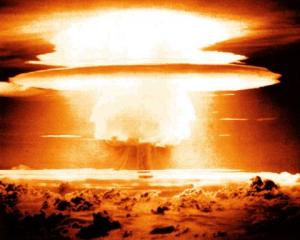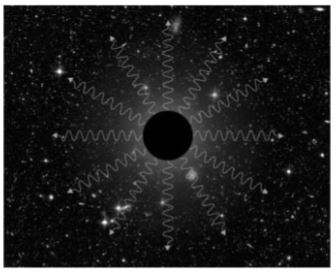So your fantasy has finally come true, you’re a space explorer!

WHEEEEE! (Slater, 2017)
As you roam the universe making your discoveries, intrepid though you are, even you know to avoid getting too close to a black hole. Your only hope is to avoid orbiting suspicious patches of darkness since black holes are so massive nothing can escape their gravitational pull, not even light, and this makes them nearly impossible to find. Well… almost.
What if I told you that black holes are just almost black? To better understand this we’re going to have to take a field trip through nuclear science, nuclear warfare, and the importance of trusting your analysis.
Nuclear Science
For this topic we will specifically be discussing a part of the electromagnetic spectrum referred to as gamma rays, found on the left of this image:

Electromagnetic Spectrum (Lucas, 2015)
Two of the four ways gamma rays can be produced are via nuclear fusion and nuclear fission (Lucas, 2018).
Nuclear fusion occurs when extreme pressure forces the protons in the nucleus of one element to combine or fuse into another, heavier element. Using the ever famous E=mc2, the resulting difference in mass is converted to energy. Some of that released energy is emitted as gamma rays. The fusion of hydrogen into helium is what powers our sun (Lucas, 2018).
Nuclear fission occurs when the nucleus of a heavy element collides with other particles and is split into lighter elements. The particles resulting from this collision can then go on to collide with other heavy nuclei, which go on to do the same, resulting in a chain reaction. The resulting loss of mass from each split is converted to energy, again using E=mc2, some of which is emitted as gamma rays (Lucas, 2018). Fission reactions using uranium or plutonium are at the core of most nuclear weapons.
Nuclear Warfare
After the use of nuclear weapons against Japan at the end of World War II, their popularity as a status symbol for world powers blossomed. With this popularity came a variety of weapons tests as nations learned more about their effects and thermonuclear weapons (two-stage fission-fusion reaction) entered the mix. As testing increased, so did knowledge of the effects of fallout, “and as it soon became apparent.. no region was untouched by radioactive debris” (U.S. DoS, 2009-2017).

Castle Bravo 1954 – 14.8 Megaton thermonuclear test (AHF, 2014)
Due to concerns involving the effects of fallout, many nations came together to eventually sign the Treaty Banning Nuclear Weapon Tests in the Atmosphere, in Outer Space, and Under Water or as it is more commonly called, the Limited Test Ban Treaty of 1963 (U.S. DoS, 2009-2017). Although treaty compliance verification was a major point of debate in forming this treaty, national technical means was the finally decided method.
The U.S. Department of Defense and U.S. Atomic Energy Commission worked together with the U.S. Air Force to launch two nuclear test detection satellites, Vela-5A and Vela-5B in 1969 (NASA, 2003). Part of the nuclear detection payload on these satellites included six gamma ray detectors (NASA, 2003).
The Importance of Trusting Your Analysis
So what does any of this have to do with black holes? I’m glad you asked (and that you’ve made it this far). In the late 1960s, Vela recorded bursts of gamma rays that did not resemble non-compliant nuclear testing and scientists soon discovered these bursts originated from deep in space, each lasting no more than 30 seconds (Bartusiak, 2018 and NASA, 2003). Technology advanced and now we know most gamma rays in space are emitted from the creation of black holes and the collision of neutron stars (Bartusiak, 2018). However, the gamma ray bursts lasting less than a tenth of a second still defied explanation.
In 1973 Soviet physicists, Yakov Zel’dovich and Alexei Starobinsky, suggested if a black hole is rotating the rotational energy would be released as radiation and the black hole would create particles (Bartusiak, 2018). Stephen Hawking expanded upon this theory explaining that all black holes would emit radiation, regardless of whether they were spinning, due to the energy of their intense gravitational fields (Bartusiak, 2018). Contrary to accepted black hole physics which claims black holes are, by their very definition, so massive that nothing can escape their pull, this theory would suggest black holes are slowly losing mass over time in the form of particles and will eventually disappear in a final violent explosion; or in the words of Hawking himself, “black holes ain’t so black” (Bartusiak, 2018).

Black hole emitting stuff like black holes… don’t? (Bartusiak, 2018)
Although Hawking estimated a black hole the size of several stellar masses would take longer than the current age of the universe to die, he also suggested the creation of micro-black holes as our universe began (Bartusiak, 2018). These “primordial black holes” (imagine a mountain compressed into the size of an atom) would experience accelerated loss over time and be going through their death throws now, releasing the same amount of energy as a million one-megaton thermonuclear bombs in the form of gamma rays (Bartusiak, 2018).
Hawking’s theory illustrates the distortion of space-time near a black hole to the point the energy of its gravitational field is converted into a matter / antimatter particle pair. Since time and distance is so fuzzy at the submicroscopic scale, it is possible for half of the particle pair to be pulled into the black hole while the other half escapes reducing the overall mass of the black hole by a tiny fraction, causing it to slowly evaporate one particle at a time (Bartusiak, 2018). In the case of a “primordial black hole,” the release of energy in its final moments would be a brief burst of gamma rays, like those first recorded by Vela, the nuclear test detection satellite (Bartusiak, 2018).
When Hawking presented this theory in 1974 at a quantum gravity conference he was met with heavy criticism from his peers, with the chairman responding that it was “absolute rubbish” (Bartusiak, 2018). However, as time progressed it became more and more clear that Hawking’s discovery demonstrated the deep connection between gravitational and quantum mechanics (Bartusiak, 2018). While searching for an answer that can explain the combination of these fields has eluded scientists for decades, Hawking proved their unification was in the realm of possibility.
References
Bartusiak, M. (2018). Dispatches From Planet 3: Thirty-Two (Brief) Tales on the Solar System, the Milky Way, and Beyond. THIRTY. The Great Escape (pp. 220-24). New Haven, & London: Yale University Press.
Lucas, J. (2018, November 29). What are Gamma-Rays?. Live Science. https://www.livescience.com/50215-gamma-rays.html
National Aeronautic and Space Administration: Goddard Space Flight Center. (2003, June 26). VELA-5A. NASA.gov. https://heasarc.gsfc.nasa.gov/docs/heasarc/missions/vela5a.html
U.S. Department of State. (2007-2017). Treaty Banning Nuclear Weapon Tests in the Atmosphere, in Outer Space, and Under Water. State.gov. https://2009-2017.state.gov/t/avc/trty/199116.htm
Image References
Atomic Heritage Foundation. (2014, June 17). Hydrogen Bomb – 1950. AtomicHeritage.org. https://www.atomicheritage.org/history/hydrogen-bomb-1950
Bartusiak, M. (2018). Dispatches From Planet 3: Thirty-Two (Brief) Tales on the Solar System, the Milky Way, and Beyond. THIRTY. The Great Escape (pp. 220-24). New Haven, & London: Yale University Press.
Lucas, J. (2015, March 13). What is Electromagnetic Radiation?. Live Science. https://www.livescience.com/38169-electromagnetism.html
Slater, N. (2017, December 19). Space Cowboy. Dribble. https://dribbble.com/shots/4032680-Space-Cowboy

